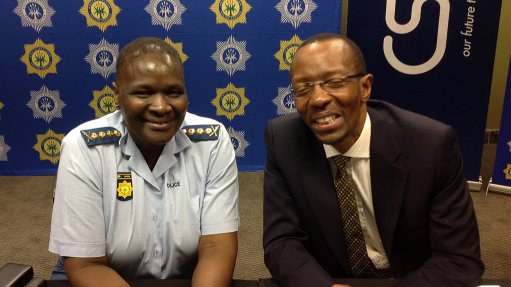
RIAH PHIYEGA AND SIBUSISO SIBISI Envisage a very close working relationship
The Council for Scientific and Industrial Research (CSIR) and the South African Police Service (SAPS) have signed a memorandum of agreement to provide the police with scientific, technological and other specialist expertise to help fight crime and improve public safety. This is the latest step in the cooperation between the two agencies, which goes back ten or more years.
“The CSIR, being a public institution, leads us [in conducting] research . . . to advance the wellbeing of the people of South Africa,” explained CSIR CEO Dr Sibusiso Sibisi. He notes that improving public safety and security is part of his organisation’s mandate.
“We want to make sure we achieve smarter interoperability of the wonderful systems we have,” affirmed National Police Commissioner General Riah Phiyega. “A synergised collective effort is needed for us to achieve a safe South Africa. The CSIR is one of the partners that we need. I hope that this new partnership will . . . add value in our fight against crime.” Cooperation with the CSIR was important to making the SAPS a pre-eminent police force.
The agreement covers research and technology support programmes in six specific areas. These are command, control and shared situational awareness, information and communication technology (ICT), integration and interoperability support, operational quick reaction missions, science and technology capability development and strategic and operational decision support.
Phiyega describes the agreement as an important step in the transformation of the SAPS. The service, she highlights, seeks to become more agile to respond more rapidly and cleverly to the needs of the people and to contribute to the wellbeing of South Africans. She notes how the country’s opening up after 1994 made it more vulnerable to organised crime and cyber crime. The police have been seeking solutions to these problems. (The SAPS has a cyber crime unit, for example, which is part of Crime Intelligence.) The cooperation with the CSIR offers access to smart technology, smart planning, and “ultimately, smart policing”.
Despite all the challenges it faces, the SAPS is striving for excellence. “We acknowledge we can do more,” she says, while pointing out that the force has already achieved a lot. “I hope that this partnership will . . . add value in our fight against crime.”
The agreement with the CSIR will also enhance the management capabilities of the police, including tender management and project management. The science council will also provide independent and unbiased evaluation of technologies that the SAPS is considering buying, ranging all the way from ICT systems to protected vehicles.
“We . . . are well positioned to be a smart adviser to enable the police service to be smart buyers of technologies, while avoiding vendor lock-in,” highlights Sibisi. In addition, the CSIR will assist in the aggregating and interpretation of data. The final objective of such data analysis will be to permit “quicker, better, smarter decisions”.
“There will also be ongoing development of technologies, informed by the specific needs of the SAPS,” he states. “We envisage a very close working relationship. We’re going to work together in a very tight manner. Let’s get on with it!”
The signing of the agreement has subsequently been welcomed by Science and Technology Minister Derek Hanekom. He notes in his statement that the agreement “will create an institutional framework for the SAPS to have direct access to a scientific, engineering and technology base to support the operational and strategic components of their safety and security duties, involving a portfolio of research and technology support programmes over a three-year period . . . Fighting crime is one of government’s five priorities, and the Department of Science and Technology commends this strategic partnership.”